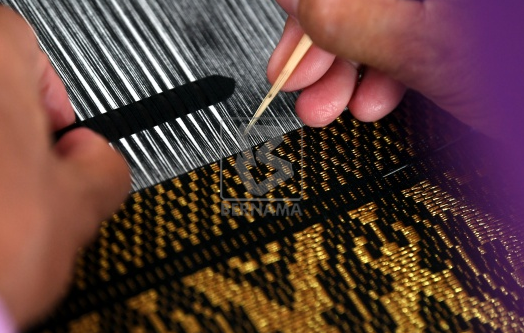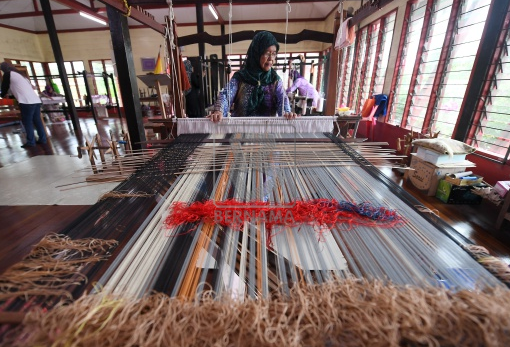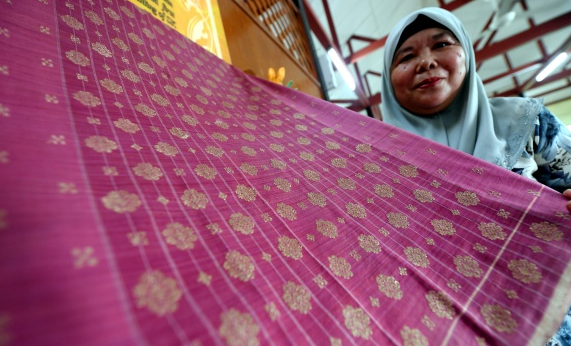
The songket produced by the weavers at Sarawak Songket Weaving Centre features the full floral motif, scattered floral motif or the stripe motif. Photo courtesy of Bernama
MUKAH June 5 (NNN-Bernama) –The Sarawak Songket Weaving Centre has what seems like a peculiar prerequisite for people who wish to take up songket weaving.
As Saanah Suhaili, who is chairman of the Rajang Songket Weaving Group that operates at the centre, puts it in Bahasa Melayu, “Sesiapa yang ingin jadi penenun di pusat ini wajib menyolek. Kalau datang dengan tidak pandai menyolek, memang tidak akan jadi songket Sarawak.” (Anyone wishing to be a weaver at this centre must be adept at making-up. If they come without being good at making-up, it will certainly not be Sarawak songket.)
For a moment this writer thought it was compulsory for all the weavers at the Sarawak Songket Weaving Centre — located in Kampung Rajang in Belawai, about an hour’s drive from Sibu — to wear make-up but Saanah, 63, quickly explained that what she meant was the weavers need to be skilled in the art of beautifying the songket. This, she added, is to ensure that the quality of the heritage craft is not compromised.
“For the ethnic Melanaus who live in this village, the word ‘menyolek’ does not mean putting make-up on the face but being skilled at beautifying the songket and enhancing its quality. Sarawak Songket’s exquisite beauty and uniqueness make it a much sought-after item and its demand usually shoots up just before Hari Raya Aidilfitri,” she said.
This writer recently visited the Sarawak Songket Weaving Centre in Kampung Rajang as part of a media tour organised by the Malaysian Handicraft Development Corporation (Kraftangan Malaysia) to look at the development of Sarawak’s textile craft industry.
SUCCESS SECRET

One of the weavers at Salmiah Aba, 73, at the Sarawak Songket Weaving Centre in Kampung Rajang has been weaving songket for 29 years. — fotoBERNAMA(2019) COPYRIGHTS RESERVED.
The hand-woven songket that emerges from the looms of the almost three-decade old weaving centre in Kampung Rajang is well-known among songket lovers.
Bowled over by the fineness and intricacy of the woven brocade and its exclusive motifs, its legion of fans includes members of the royalty and top politicians who would wear it when attending official functions or during festive occasions.
In fact, Saanah and her team of seven artisans at the weaving centre have been kept busy completing orders for Hari Raya Aidilfitri that had poured in since the end of last year.
Saanah, who has been weaving songket for 29 years, said the secret of Sarawak songket’s success lies in the ‘menyolek’ or ‘make-up’ skills of the weavers and their ability to produce unique works of art.
Sarawak songket is different from the songket produced in the east coast states of Terengganu and Kelantan as it (Sarawak) uses the hidden thread technique to ensure that the back of the fabric is also neatly woven.

Saanah Suhaili, chairman of the Rajang Songket Weaving Group. –fotoBERNAMA(2019) COPYRIGHTS RESERVED
This means that the Sarawak songket can be worn on either side as the weaving pattern is the same on both sides.
Saanah said while the weaving process for Sarawak songket and Terengganu and Kelantan songket was generally similar, her weavers use a special 30 ‘sifir’ or multiplication formula which she and another songket weaver Dayang Norsalam Pengiran Parsih devised in 1993.
The formula is essentially about counting the number of threads used and according to Saanah, the weaver has to master the multiplication technique first before learning the other processes related to songket weaving.
“All the weavers at our centre have to be well-versed with this formula as it is the main basis of the hidden thread technique, as well as the designs for the motifs on the songket fabric,” she explained.
PRICE
Saanah and her weavers’ songket pieces are priced at about RM900 each but the more exquisite ones can cost as high as RM10,000.
Saanah, who had in the past been conferred the Outstanding Sarawak Songket Weaver award by Kraftangan Malaysia, said the price would depend on the intricacy of the motif, type of thread used and how long it took to complete the songket piece.
The songket produced by the weavers at Sarawak Songket Weaving Centre features the full floral motif, scattered floral motif or the stripe motif.
“It is more costly to make songket featuring the scattered floral motif than the one with full floral motif. Not only does it require more thread, it is also a laborious process as the floral motif has to be woven one at a time and it can take up to three months to complete a piece,” she said.
For this Hari Raya, she added, her customers seemed to favour the mangosteen calyx and eight-petal flower motifs for the songket fabrics they had ordered from her centre.
“Black is their favourite colour as it can be easily matched with other colours,” she said.
A DYING ART
Meanwhile, Saanah, who learnt the art of weaving songket from her mother, is grateful to Kraftangan Malaysia and the Sarawak Economic Development Corporation for helping to promote her centre’s products globally and organising songket weaving workshops.
“Our products have a wider reach now and have even been sold in countries like Australia and New Zealand,” she said, adding that the two agencies have also extended aid in the form of raw materials, sales promotions and product improvement.
“Thanks to these agencies, Sarawak songket has once again become popular in this kampung, which used to be known for its songket many years back. However, in 1972 many of the weavers gave up songket weaving due to the difficulty in procuring thread.”
Although the revival of the local songket industry has made her happy, Saanah cannot help worrying about the future as not many youngsters in the village seemed interested in learning the heritage art.
She and the other existing weavers were not only getting older but they don’t have children who they can pass skills to as most of them are not married.
One of the weavers Salmiah Aba, who has been weaving songket for 29 years, is now 73 years old and she admitted that she was not as energetic as before. Initially, there were 19 weavers at the centre and the number has now dwindled to eight, she said.
“The younger generation feels that there’s not much money to be made in songket weaving but they are wrong. Right now, we don’t have people who will take over from us but I hope we can pass our skills to the younger generation someday and keep this art alive,” she added.
NNN-Bernama





